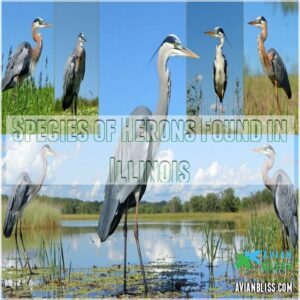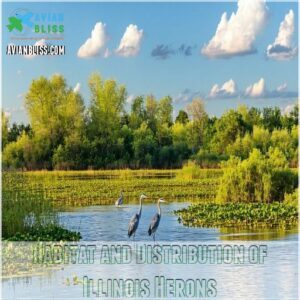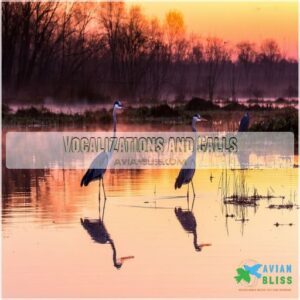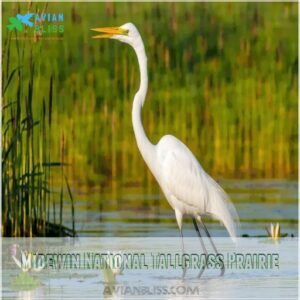This site is supported by our readers. We may earn a commission, at no cost to you, if you purchase through links.
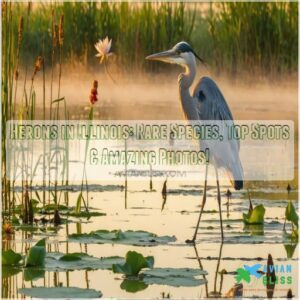
Herons thrive in wetlands, rivers, and even urban parks, effortlessly blending into their surroundings. These feathered fishers don’t just look cool—they help balance ecosystems by keeping fish populations in check.
But they’re not without challenges: habitat loss, pollution, and climate change all threaten their survival. Want to see herons in action? Visit Lake Renwick for unbeatable views, but don’t be surprised if they outsmart you at hide-and-seek!
Table Of Contents
- Key Takeaways
- Species of Herons Found in Illinois
- Habitat and Distribution of Illinois Herons
- Identifying Herons in Illinois
- Heron Feeding Habits and Prey
- Breeding and Nesting Behaviors of Illinois Herons
- Conservation Status of Herons in Illinois
- Heron Watching Hotspots in Illinois
- Herons’ Role in Illinois Ecosystems
- Seasonal Patterns of Herons in Illinois
- Human Interactions With Illinois Herons
- Frequently Asked Questions (FAQs)
- Did I see a crane or a heron?
- Is there a difference between a heron and an egret?
- What is the difference between a grey heron and a great blue heron?
- Why would a blue heron be in my yard?
- What is the difference between a great egret and a heron?
- Is it a blue heron or GREY heron?
- Are herons protected in Illinois?
- What is the average lifespan of Illinois herons?
- How do herons adapt to urban environments?
- What threats do herons face in Illinois?
- Conclusion
Key Takeaways
- You’ll find seven heron species in Illinois, like the Great Blue Heron and the secretive American Bittern, each thriving in wetlands, rivers, and even urban parks.
- Herons play a critical role in maintaining ecosystem balance by controlling fish populations and indicating wetland health.
- Habitat loss, pollution, and climate change are major threats to herons, but local conservation efforts and habitat restoration are working to protect them.
- Top birdwatching spots include Lake Renwick, Illinois Beach State Park, and Volo Bog, offering unique opportunities to see these graceful birds up close.
Species of Herons Found in Illinois
If you’re a bird enthusiast in Illinois, you’ll be thrilled to discover seven incredible heron species that call this state home.
From the majestic Great Blue Heron to the secretive American Bittern, each species has its unique characteristics.
From hunting techniques to habitat preferences, making Illinois a surprising hotspot for these fascinating wading birds.
Great Blue Heron
When summer rolls in, you’ll spot Great Blue Herons hunting across Illinois wetlands like seasoned fishermen.
These magnificent birds boast incredible adaptations:
- S-curved neck for lightning-fast strikes
- Razor-sharp bill for precision hunting
- Impressive wingspan spanning up to 6 feet
With their distinctive blue-gray plumage, they’re nature’s most elegant predators, transforming quiet marshes into dynamic hunting grounds for fish, frogs, and small mammals, making them seasoned fishermen.
American Bittern
Hidden among the reeds of Illinois wetlands, the American bittern plays hide-and-seek like a pro.
With buffy brown feathers that vanish into marshgrass, this secretive heron blends perfectly with its surroundings.
Listen for its bizarre "oong-KA-chunk" call – a telltale sign of this master of camouflage prowling through its watery domain.
Black-crowned Night-Heron
Night prowlers with a jet-black crown, Black-crowned Night-Herons dominate Illinois’ endangered bird scene.
They’ve carved out a remarkable niche in urban environments like Chicago, their distinctive "quawk" piercing city nights.
Despite state-endangered status since 1977, these resilient herons survive through strategic roosting habits and adaptive nocturnal behaviors at the Lincoln Park Zoo’s sole remaining rookery.
Conservation efforts are underway, with researchers studying urban ecology to better understand and protect the species.
Green Heron
A clever Green Heron might just catch you by surprise in Illinois’ lush landscapes. These pint-sized predators are masters of disguise, blending into their surroundings with remarkable skill.
- Expertly use insects as fishing bait
- Camouflage themselves in dense vegetation
- Thrive in urban parks and wetlands
- Make distinctive "skeow" calls at dawn
Watch closely—they’re nature’s stealthy hunters!
Great Egret
After the Green Heron‘s stealthy fishing, the Great Egret struts onto the scene – Illinois’ most photogenic heron.
With snow-white plumage and razor-sharp hunting skills, these birds dominate wetland ecosystems from mid-March to November.
The great egret behavior is characterized by patient stalking and ambush tactics, making them highly effective hunters.
Spot them in marshes, lakes, and urban green spaces, using their daggerlike bill to snag fish, frogs, and small mammals with stunning precision.
Tricolored Heron
If you’ve been tracking heron migration in Illinois, the rare Tricolored Heron will catch your eye.
Sporting a unique blue-gray, white, and chestnut wardrobe, these medium-sized waders dance through wetlands with surgical precision.
Birdwatchers get a real treat – these elusive herons showcase nature’s artistic flair while hunting along Lake Michigan’s shores, providing a glimpse of surgical precision.
Reddish Egret
Wandering into rare bird territory, the Reddish Egret stands out as a quirky visitor to Illinois’ waterways.
Though uncommon, this dance-hunting heron captivates birdwatchers with its unique foraging style.
Tracking its feeding habits and migration routes reveals a fascinating story of survival, making every glimpse a treasure for conservation-minded nature enthusiasts.
Habitat and Distribution of Illinois Herons
If you’ve ever wondered where to spot herons in Illinois, you’re in for a treat!
From the lush wetlands of Lake Renwick to the urban green spaces of Chicago, these magnificent birds have found their perfect home across the state’s diverse landscapes.
Freshwater Marshes and Wetlands
Dive into Illinois’ freshwater marshes, where herons dance among cattails and hidden ecosystems thrive! These watery wonderlands support incredible wildlife and play key roles in environmental health.
Understanding wetland communities is essential for conservation efforts, as they provide important habitats for various species, including herons.
- Protect water quality through strategic wetland restoration
- Create wildlife refuges that nurture diverse aquatic life and native heron populations
Preserve these magical habitats—nature’s living, breathing sanctuaries!
Lakes, Ponds, and Rivers
Step beyond marshes and you’ll discover Illinois’ lakes, ponds, and rivers—prime hunting grounds for herons.
Black-crowned night-herons and great blue herons navigate these aquatic landscapes, using river currents and shoreline features as natural fishing spots.
Water quality impacts these rich heron habitats, where aquatic life thrives beneath rippling surfaces.
Each river bend and pond edge tells a story of survival, showcasing the remarkable adaptability of these feathered predators in their watery world.
Urban Parks and Green Spaces
Every urban park holds a secret world where herons thrive amid concrete landscapes. These remarkable birds transform city green spaces into unexpected wildlife sanctuaries:
- Green herons camouflage near community garden edges
- Black-crowned night-herons perch on park infrastructure
- Great blue herons navigate urban ecosystem networks
- Surprising wildlife adapt to park design challenges
Understanding urban wildlife is essential for effective conservation efforts.
Illinois’ urban wildlife reveals nature’s remarkable resilience in unexpected city corners, with a link to learn more about urban wildlife
Coastal Areas Along Lake Michigan
Along Lake Michigan’s windswept coastline, a vibrant ecosystem unfolds for Illinois’ herons.
Shoreline erosion and fluctuating water levels create dynamic beach habitats that support diverse coastal wildlife.
Great Blue Herons and Black-crowned Night-Herons navigate these challenging landscapes, hunting among rocky shores and wind-sculpted dunes.
Each heron species adapts uniquely to Lake Michigan’s ever-changing coastal environment, transforming these shorelines into critical wildlife sanctuaries that showcase the resilience of Illinois’ remarkable bird populations.
Seasonal Migration Patterns
Most herons in Illinois transform into winged wanderers when seasonal shifts beckon them southward.
Their migration is a precise dance of survival guided by instinct and environmental cues.
Here’s what makes their journey remarkable:
- Navigate intricate flyway patterns across illinois birding trails
- Utilize strategic stopover sites for rest and refueling
- Adapt to changing habitat shifts during breeding seasons
- Follow generations-old migration routes through diverse landscapes
Identifying Herons in Illinois
Want to become a heron detective in Illinois?
You’ll want to master key identification tricks like checking out size, color patterns, unique calls, and distinctive flight silhouettes that’ll help you spot these fascinating waterbirds in their natural habitats.
Physical Characteristics and Markings
Bird detectives, grab your binoculars! Identifying herons in Illinois is all about decoding their unique feather patterns and beak shapes.
From the Great Blue Heron’s distinctive eye stripes to the subtle leg colors of different heron species, each bird tells a story.
Scan for head plumes, note bill lengths, and watch how these Illinois bird species blend into their watery habitats with camouflage that’ll make your jaw drop.
Size and Shape Variations
After exploring colorful markings, let’s decode the yoga of heron shapes!
Your field guide to Illinois heron species unfolds through four key dimensions:
- Wingspan: From compact to impressive wing-spreads
- Bill Length: Ranging from needle-sharp to broad-tipped
- Body Proportions: Gangly giants versus compact hunters
- Leg Length: Nature’s stilts defining each unique silhouette
Human height comparisons won’t help – these feathered friends play by their own rules!
Flight Patterns and Silhouettes
Spotting herons in Illinois often reveals their unmistakable airborne silhouettes. Their expansive wings slice through the sky with deliberate, slow wing beats, long legs trailing behind like elegant landing gear. Their S-shaped necks and distinctive flight speed make these Illinois heron species truly mesmerizing in motion.
Understanding wetland habitats is essential for identifying heron species and their behaviors.
Vocalizations and Calls
Nature’s symphony comes alive through heron vocalizations in Illinois. These feathered communicators express themselves through a rich language of sounds.
- Harsh "quawk" alarm calls echoing across wetlands
- Guttural croaks signaling territorial boundaries
- High-pitched "skree" piercing through misty mornings
- Soft grunting exchanges between nesting partners
Each call reveals a unique chapter in their wild story.
Behavioral Traits
Watch a heron in action, and you’ll witness nature’s most precise predators.
Their hunting strategies reveal calculated movements – stalking silently, striking with lightning speed.
These birds communicate through elaborate mating displays and territorial defense, blending stealth with social complexity.
Their foraging behaviors and nesting habits showcase remarkable adaptations that have perfected survival in Illinois’ diverse landscapes.
Heron Feeding Habits and Prey
When you’re exploring Illinois’ wetlands, you’ll discover that herons are master hunters with incredible fishing skills.
Watch these fascinating birds patiently stalk their prey in shallow waters, using lightning-fast strikes to catch fish, frogs, and other small aquatic creatures that make up their diverse diet.
Hunting Techniques and Strategies
Herons creep up on their prey like silent hunters in Illinois wetlands.
Their hunting prowess involves three key strategies:
- Camouflage and stillness in marshy terrains
- Strategic positioning near water edges
- Lightning-fast strikes with razor-sharp beaks
Great Blue Herons master ambush tactics, blending perfectly into their habitat.
They’re nature’s precision predators, using stealth methods that would make any wildlife photographer’s jaw drop.
Common Prey Items in Illinois
Ever wonder what fuels these long-legged hunters prowling Illinois’ waterways? These avian predators have quite the menu:
- Native fish like sunfish and bass
- Invasive carp swimming unsuspectingly
- Plump bullfrogs lounging near shorelines
- Tiny muskrats scurrying through marsh grasses
Their fish diets shift with seasons, turning Illinois’ wetlands into a buffet of aquatic creatures. From shallow streams to murky ponds, these skilled heron species are always ready to strike, making every meal a calculated hunt.
Adaptations for Catching Fish
Sharp bills like nature’s spears slice through water, letting Illinois heron bird species snatch fish with precision.
Their leg strength propels lightning-fast strikes, while unique beak shapes slice through scales effortlessly.
Great blue herons leverage hunting tactics perfected over millennia, blending camouflage and feather colors to become invisible predators in heron habitats across waterways.
Foraging Areas and Times
Hunting for Illinois herons? Your best bet is strategic timing and location scouting.
These skilled waterbirds turn wetland foraging into an art form, prowling prime fishing spots with precision.
Perfect your heron-watching skills with these insider tips:
- Dawn and dusk offer prime hunting windows
- Shallow marshes become feeding headquarters
- Wetland edges provide maximum prey opportunities
- Quiet areas mean less competition for food
Seasonal Diet Variations
Explore the culinary world of Illinois herons as they navigate seasonal menu changes with wilderness wisdom.
Their diet transforms with nature’s rhythm, revealing fascinating foraging strategies.
Their diet includes various food sources, such as:
- Pivot to amphibian feasts when fish retreat
- Scavenge small mammals during lean winter months
- Compete with waterfowl for limited prey
- Demonstrate remarkable adaptability in challenging environments
Breeding and Nesting Behaviors of Illinois Herons
You’ll be amazed by the intricate breeding and nesting behaviors of Illinois herons, where each species has its unique approach to love, home-building, and family life.
From the towering rookeries of Great Blue Herons to the hidden nests of secretive Green Herons, you’ll discover how these remarkable birds create and protect their next generation in the state’s diverse wetland habitats.
Courtship Rituals and Displays
Watch Great Blue Herons transform into dancing divas during breeding season!
Their mating displays are nature’s own reality show – intricate ritual performances featuring flashy plumage, dramatic posturing, and loud courtship calls.
Males strut their stuff, stretching elegant neck feathers and performing choreographed movements to win a mate’s heart in Illinois’ wetland stages.
Nest Construction and Materials
Ever wonder how herons craft their sky-high homes? These winged architects are masters of nest construction in Illinois wetland habitats.
Here’s their blueprint for the perfect heron nest:
- Gather sturdy sticks from nearby tree branches
- Select tall trees near water for maximum safety
- Weave intricate platform nests over four feet wide
- Line nest with softer materials for chick comfort
Herons: nature’s ultimate home builders! They are known for their impressive nest construction skills.
Egg Laying and Incubation
When nesting, Great Blue Herons transform their chosen tree into a bustling nursery.
Females typically lay 3-6 bluish-green eggs in carefully constructed nests, strategically positioned near water in Illinois wetlands.
The incubation journey spans roughly 25 days, with both parents tag-teaming egg-warming duties. Their brood care demonstrates nature’s intricate dance of survival, ensuring each precious egg gets the royal treatment in these elevated woodland nurseries.
Chick Rearing and Development
After eggs hatch, Great Blue Heron parents spring into action, feeding nestlings a protein-packed diet of fish and aquatic creatures.
Chicks grow rapidly, developing downy feathers and strengthening muscles for future flight.
Understanding heron habitats is essential for conservation efforts, as these birds rely on specific environments to thrive.
From vulnerable hatchlings to robust fledglings, these young herons transform in their carefully guarded nest, embodying nature’s remarkable resilience.
Colony Formation and Rookeries
Explore the domain of heron rookeries, where these fascinating birds build their bustling neighborhoods.
Their colony dynamics reveal nature’s intricate social blueprint:
- Strategic nest site selection
- Complex inter-species relationships
- Collaborative community defense
Threatened by habitat loss, these avian communities showcase the delicate balance of survival and cooperation in Illinois’ vibrant wetland ecosystems.
Conservation Status of Herons in Illinois
If you’re wondering about the health of Illinois’ heron populations, you’ll want to understand the challenges these magnificent birds face.
From habitat loss to climate change, herons in Illinois are coping with a complex landscape of environmental pressures that could impact their future survival.
Endangered and Threatened Species
Hang tight on Illinois’ heron conservation journey! Some species are hanging by a thread, with human impact and climate change threatening their survival.
Wildlife experts are stepping up, protecting key habitats and tracking population trends.
Your awareness matters – these magnificent birds need champions to keep their wings spread wide across our state’s delicate ecosystems, and support their survival.
Habitat Loss and Fragmentation
When endangered heron populations shrink, fragmented landscapes spell trouble.
Illinois’ wildlife corridors are vanishing, splitting essential wetland habitats. Urban sprawl chips away at nesting sites, disrupting delicate ecosystems.
By supporting local conservation efforts, you can help reconnect these broken green spaces and give herons a fighting chance to survive and thrive.
Water Pollution and Contaminants
Beneath Illinois’ waters, toxic pollution threatens heron habitats like a silent predator. Chemical runoff and sewage spills create a toxic cocktail for these elegant waterbirds.
- Plastic waste chokes freshwater ecosystems
- Oil leaks disrupt delicate wetland balance
- Persistent contaminants compromise heron survival
Your awareness and action can transform these fragile habitats, protecting Illinois’ incredible heron populations from environmental destruction.
Climate Change Impacts
Climate change throws Illinois herons a curveball, scrambling their migration and survival strategies.
Sea level shifts and extreme weather disrupt critical habitats, forcing these birds to adapt or perish.
Dwindling wetlands and unpredictable temperature changes challenge heron populations, turning their once-stable Illinois wildlife refuges into a high-stakes game of ecological roulette.
Conservation Efforts and Programs
As climate change threatens heron habitats, local conservation teams are stepping up.
Join wildlife management programs that protect Illinois’ heron populations through strategic ecosystem services.
Volunteer for habitat restoration projects, participate in species protection initiatives, and help track these magnificent birds, this can be part of heron conservation efforts.
Your passion can turn the tide for heron conservation efforts across the state’s precious wildlife refuges.
Heron Watching Hotspots in Illinois
If you’re itching to spot some of Illinois’ most magnificent feathered friends, you’re in luck with a handful of prime heron-watching locations scattered across the state.
From the Lake Renwick Heron Rookery Nature Preserve to the sprawling Midewin National Tallgrass Prairie, you’ll find plenty of opportunities to observe these elegant water birds in their natural habitats.
Lake Renwick Heron Rookery Nature Preserve
After protecting herons through conservation efforts, birdwatchers can explore the Lake Renwick Heron Rookery Nature Preserve, a stunning wildlife refuge for Illinois bird species.
Understanding wetland habitats is essential for effective heron conservation and management. This sanctuary offers an intimate glimpse into herons’ secret world, where these elegant birds transform ordinary landscapes into extraordinary theaters of natural drama.
The sanctuary provides various experiences, including:
- Witness dramatic heron nesting behaviors
- Experience pristine wetland ecosystems
- Observe rare rookery management techniques
- Discover critical heron habitat conservation
Bring binoculars and prepare for an unforgettable wildlife encounter!
Illinois Beach State Park
Grab your binoculars and trail map at Illinois Beach State Park, where heron habitat meets visitor paradise.
Great blue herons and other illinois wetland birds thrive here, offering spectacular wildlife viewing opportunities.
Watch nesting behaviors, snap incredible photos, and respect park rules.
Your quiet steps might reveal secret moments in these winged residents’ daily lives – just remember, you’re a guest in their world.
Volo Bog State Natural Area
At the crossroads of + in Volo Bog State Natural Area, you’ll discover a heron haven waiting to reveal its secrets:
- 30+ acres of pristine bog ecology
- Critical heron habitat for Illinois wetland birds
- Uninterrupted wildlife migration corridors
- Accessible nature trails for quiet observation
- Unique wetland plant communities supporting bird diversity
Your adventure into Illinois’ hidden wilderness starts here – where silence speaks volumes and herons rule the landscape.
Midewin National Tallgrass Prairie
Nestled within Illinois’ landscape, Midewin National Tallgrass Prairie offers a sanctuary where heron conservation thrives.
Wander through restored wetlands and witness American bitterns camouflaged in lush grasses, while great egrets dance across the prairie sky.
This native ecosystem reveals the delicate balance of Illinois’ wildlife preservation efforts, inviting nature enthusiasts to explore its hidden wonders.
Urban Heron Watching Locations
Three urban havens reveal Chicago’s hidden heron haven! City Parks become unexpected wildlife stages where river walks and green roofs transform ordinary landscapes into extraordinary bird watching destinations.
- Lincoln Park: Where Great Blue Herons dance between skyscrapers and trees
- Humboldt Park: Discover secretive Green Herons thriving in unexpected urban wetlands
Herons’ Role in Illinois Ecosystems
You mightn’t realize it, but herons play a huge role in keeping Illinois’ ecosystems healthy and balanced.
These graceful birds control fish populations, cycle nutrients, and even signal the health of wetlands with their presence.
Ecological Importance as Predators
Herons of Illinois are nature’s skillful hunters, essential for ecosystem balance.
As top-tier predators, they regulate prey populations, like fish and amphibians, sustaining healthy food webs.
Their biodiversity role guarantees vibrant aquatic habitats teeming with life.
Highlighting herons’ conservation value emphasizes protecting heron habitats in Illinois, safeguarding these ecological clean-up crews for future bird conservation efforts.
Indicator Species for Wetland Health
When you see herons thriving in Illinois wetland habitats, it’s like nature saying, “All systems go!” These graceful birds clue us in on ecosystem health.
Here’s why:
- Water pollution is minimal if herons are abundant.
- Wetland quality supports rich biodiversity like fish and frogs.
- Habitat loss hasn’t disrupted their delicate balance.
Keep an eye on heron populations!
Nutrient Cycling in Aquatic Environments
Ever notice how herons indirectly clean up wetland habitats? In Illinois, these waterbirds influence water quality and sediment dynamics by eating fish, amphibians, and aquatic plants, keeping ecosystems balanced.
Their presence boosts microbial activity and nutrient cycling, benefiting aquatic vegetation. Supporting heron conservation efforts is essential for maintaining these delicate balances.
Maintaining heron habitat in Illinois isn’t just heron conservation—it’s also preserving vibrant Illinois waterbirds and healthy ecosystems.
Interactions With Other Wildlife
Herons in Illinois are multitaskers in the wild. They navigate predator avoidance, compete with other birds for prey, and share habitats like pros.
- Prey competition with ducks, grebes, or other waterbirds is common.
- They build ecosystems supporting species symbiosis, like marsh plants thriving near rookeries.
- Herons use wildlife corridors, adapting to urban spaces.
- Their interactions sustain heron populations Illinois cherishes!
Impact on Fish Populations
You’ve got to admire the sneaky skills of great blue herons and other Illinois herons—they’re top-tier predators.
While their hunting keeps fish in check, it rarely leads to fish decline. Instead, it maintains aquatic balance.
Here’s a breakdown:
| Heron Species | Impact on Fish Stocks | Ecosystem Role | Notes |
|---|---|---|---|
| Great Blue Heron | Moderate | Balances prey levels | Year-round in Illinois |
| Green Heron | Low | Ambush hunter | Seasonal breeds in wetlands |
| Black-crowned Night | Low-Moderate | Nocturnal control | Active at dusk/night |
| American Bittern | Minimal | Rare predator-prey impact | Secretive marsh dweller |
Seasonal Patterns of Herons in Illinois
You’ll notice herons in Illinois shifting habits with the seasons, from spring nesting to fall migration.
Some stick around all year, while others chase warmer weather, proving birds can have travel schedules too!
Spring Arrival and Breeding Season
The spring season in Illinois brings a flurry of activity as herons begin their mating rituals and stake out prime heron nesting sites. Great Blue Herons and others can be seen performing elaborate displays to attract mates.
Once paired, they carefully choose nesting sites in colonies, often near water. Storms, though, can put their hard work at risk.
This season also marks the start of their breeding habits, with egg-laying kicking off the journey to the fledgling stage.
- Key highlights:
- Nest scouting and colony formation.
- Dramatic courtship and displays.
- Resilience in face of storms.
Summer Feeding and Chick Rearing
Summer in heron habitat Illinois is buzzing with action! Watch Great Blue Heron parents tirelessly feed their growing chicks. It’s a balancing act of Parental Care and competition for food.
Here’s what to expect:
- Chicks practice fishing as they grow fast.
- Parents perfect Feeding Strategies.
- Nest Safety is critical for fledgling success.
- Fierce sibling squabbles over meals!
Fall Migration Preparation
Herons in Illinois are busy strategizing their fall migration. You’ll spot them fine-tuning flight formations and flocking patterns at nature preserves or wetlands.
Stopover sites become bustling hubs as they refuel with expert fueling strategies to prep for long migration routes.
These heron sightings highlight migration magic and showcase the importance of Illinois bird conservation and heron conservation efforts.
Winter Survival Strategies
Cold weather makes life tricky for herons, but they’ve got strategies. Some stick to unfrozen water pockets for food storage, while others adjust migration routes.
Flocking behavior helps conserve warmth at sheltered roosting sites. Understanding heron habitats is essential for grasping their survival techniques.
Great Blue Herons especially show resilience, with heron sightings in Illinois increasing near heated areas or Illinois nature preserves.
Year-round Resident Species
When the wind bites and ponds freeze, year-round resident birds like the Great Blue Heron stay put.
These masters of species adaptation rely on feather care and strategic foraging to weather the cold.
Open water is critical for their habitat needs, offering fish for food.
You’ll glimpse them in wetlands or along rivers, a demonstration of heron conservation in Illinois and survival.
Human Interactions With Illinois Herons
You’ll find herons gracefully adapting to both wild and urban spaces across Illinois, creating unique opportunities for surprising encounters.
From peaceful birdwatching moments to debates about their fishing habits, these birds always find a way to keep us curious.
Birdwatching and Photography Opportunities
Grab your bird cameras and head out to witness stunning heron sightings in Illinois.
Bring wildlife lenses for sharp shots and try these top tips:
- Visit Lake Renwick for Great Blue Herons.
- Use bird hides for close encounters.
- Scout herons at dawn.
- Pack reliable camera gear.
- Respect birds’ space—no startled flights!
Conflicts With Fisheries and Aquaculture
Herons in Illinois, like the Great Blue Heron, can clash with fish farming due to their hunting skills.
To balance profits and nature, try netting ponds or using deterrents like reflective tapes.
Here’s a quick look:
| Challenge | Solution |
|---|---|
| Fish loss | Pond netting |
| Aquatic pollution risk | Water monitoring tools |
| Overfishing effects | Adjust harvest schedules |
| Habitat destruction | Preserve wetland edges |
| Net entanglement risks | Use safer materials |
Urban Adaptations of Herons
Great Blue Herons and other herons in Illinois are making themselves at home in city habitats. Urban roosts, parks, and waterways provide new spots for urban foraging despite human conflict challenges like noise and pollution. These clever birds adapt well to city life, blending in beautifully.
The installation of urban bird houses can further support the growth of heron populations in urban areas.
- City habitats offer plenty of food sources.
- Urban roosts often include trees in parks.
- Heron adaptations show resilience in urban environments.
Cultural Significance and Symbolism
The Great Blue Heron represents patience, strength, and harmony across Native American mythology and folklore.
Its grace inspires spirituality and countless art forms, reflecting timeless beauty.
As a symbol of heron conservation in Illinois, it reminds us of nature’s fragility.
Spotting herons in Illinois can feel magical—like meeting an ancient guardian of Illinois wildlife during serene bird watching moments.
Citizen Science and Research Projects
Inspired by herons’ symbolic grace? You can make a real impact through heron conservation in Illinois!
Get involved with citizen science projects like wildlife surveys, species tracking, and habitat monitoring.
Sharing your heron sightings in Illinois during bird-watching trips adds valuable data to conservation efforts.
Whether it’s contributing to Illinois heron research or joining local data collection, you’re helping safeguard wetlands. Feel like a scientist and protector, all while loving nature!
Frequently Asked Questions (FAQs)
Did I see a crane or a heron?
It’s funny how similar they look, right?
Cranes are taller, with straighter necks and a red crown, while herons fold their necks into an "S" when flying.
Spot that neck? It’s a heron!
Is there a difference between a heron and an egret?
Herons and egrets are closely related but differ mostly in size, color, and plumage.
Egrets are generally white and sport fancy breeding plumes, while herons come in varied colors and tend to be slightly larger.
What is the difference between a grey heron and a great blue heron?
A stunning 4-foot wingspan makes the Great Blue Heron larger than the Gray Heron.
They’re similar in appearance, but Great Blues have bolder black head markings, while Gray Herons look sleeker with paler coloring.
Why would a blue heron be in my yard?
A Great Blue Heron might visit your yard if there’s a nearby water feature or pond with fish or frogs.
They’re expert hunters and often wander into residential areas when searching for food.
What is the difference between a great egret and a heron?
A great egret stands out with its pure white feathers, yellow bill, and black legs, while herons, like the great blue heron, usually have grayish-blue plumage, a heavier build, and slower, deliberate movements.
To understand the main differences, consider the egret vs heron characteristics that set these birds apart regarding physical appearance and behavior.
Is it a blue heron or GREY heron?
Think of it like paint swatches—Great Blue Herons are native to North America and have bluish-gray feathers.
While Grey Herons are found in Europe and Asia, resembling their blue cousins but with paler tones.
Are herons protected in Illinois?
Herons are protected in Illinois under federal and state laws, including the Migratory Bird Treaty Act.
This protection makes it illegal to harm these elegant birds or disturb their nests.
What is the average lifespan of Illinois herons?
Most herons live around 15 years, but some Great Blue Herons have hit 24 years!
Your local Illinois herons enjoy long lives thanks to protected habitats, plenty of food, and their knack for staying stealthy.
How do herons adapt to urban environments?
Herons adapt to urban settings by nesting in parks, golf courses, and near stormwater ponds.
They adjust their diets to include urban food sources like fish from decorative ponds, showcasing their versatility and resourcefulness in city life.
What threats do herons face in Illinois?
Picture a wetland shrinking like a puddle on a hot day—herons in Illinois face habitat loss, water pollution, and human disturbances.
These threats make survival tricky, especially with competition for food and nesting spots.
Conclusion
Think of herons in Illinois as nature’s stealthy anglers, silently shaping wetlands with grace and purpose.
Whether you’re marveling at a Great Blue Heron’s slow hunt or catching rare glimpses of a Reddish Egret, these birds connect you to the rhythms of local ecosystems.
Explore habitats, snap incredible photos, and appreciate their role in balancing aquatic life.
Keep your eyes peeled—Illinois’ herons are both elusive and awe-inspiring, offering endless moments of discovery in their natural haunts.

